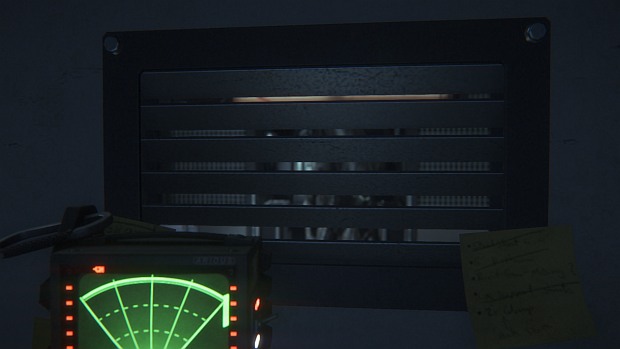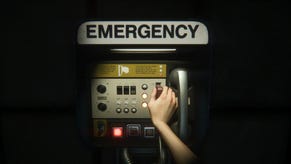How Do Alien Isolation's Lockers Work?
The Mechanic
This is the first entry in a new column called The Mechanic, where Alex Wiltshire invites a developer to help him put their game up on blocks and take a wrench to hack out its best feature, just to see how it works. It’s about the sweat, grease and genius behind the little things that make games special.
Alien: Isolation is an AI-driven science-fiction horror game featuring, for the most part, a single, unstoppable opponent. It’s pretty much a game version of the first Alien film: confined to a space, all you can do about the xenomorph that’s hunting you down is to distract, avoid or briefly scare it. And all around you lies terrible temptation. They feel like they’ll solve all your problems. They feel like safety. They feel like places you should stay inside. But they won’t; they aren’t; you shouldn’t. They are:
THE MECHANIC: Lockers
You can really imagine the dull, corporation-driven lives that were led in the space station Sevastopol. A population sitting at desks, grumbling at each other over email on green-screen terminals. Alien: Isolation captures the same heightened sense of the everyday that makes the original Alien film so starkly convincing, and similarly sets one heck of a stage for all the awful, horrible things that ensue.
The plot, which is basically a very elongated version of the bit in Alien where Ripley has to set the auto-destruct sequence, has you traverse and re-traverse location after location to maximise your contact with the alien. It’s a game about the dynamics of careful movement and observation: watch the alien, plan your actions, execute. This means that Alien: Isolation is definitely not about lockers, because lockers are the opposite of movement and observation. And yet I, like many other players, spent a good deal of time in them, and correspondingly it turns out that quite a lot of thinking went into lockers, about what place they take in the game’s overall design and how they work.
And also, quite a lot of not thinking at all. “Of course we’d have lockers that you can hide in,” says Al Hope, Alien: Isolation’s creative director, about the fact they’re in the game at all. But they were still the last of the major hiding places his team implemented. Space stations aren’t, of course, organic spaces, and being packed-in to use their volumes efficiently, they offer a limited spatial vocabulary. With this in mind, Creative Assembly started designing appropriate objects to hide behind, then objects to hide under, then air ducts, and only then did lockers come into the game, the result of surveying already-created props for suitable objects to hide inside.
That you should be able to hide at all in Alien: Isolation came from very early discussions about what it’d mean to be trapped in confined spaces with a lethal, fast and unpredictable alien. “What would we do?” says Hope. “I’d duck behind a table and make sure it couldn’t see me. I’d creep around and try to be quiet; we wanted to take advantage of very intuitive survival skills.” To get players behaving so instinctively meant making the Sebastopol feel like a real place. Just as the alien had to behave coherently, like a living being with a mind of its own and habits that you could observe and exploit to survive, the environments had to offer features you’d innately turn to for support. “That’s a natural thing, to try to do something to make yourself feel a little bit safer, buy some time; the priority is what you can do right now to make you feel less under threat.”
The interesting thing about lockers, though, is how they’re different to the other means of hiding in the game. If you’re under a table you can see a fair amount, scoot around to stay out of view and exit from another angle. But once inside a locker, you’re trapped and your view’s restricted. An Alien: Isolation locker is struck through with a big tradeoff: for the hope of concealment you’re backing yourself into a corner, drastically reducing your number of options.
“We never wanted the player to ever feel 100% safe,” says Hope. “This isn’t your home, this isn’t somewhere you will want to stay in for a long time. It’s to communicate, subconsciously, that it’s temporary and you will probably want to move on as fast as possible.” Because while lockers are there to give sanctuary, the game would fail if it became an exercise in jumping between them as if they’re islands of safety. “We always tried to have some kind of risk or cost associated with every action,” says Hope. “The game is about taking risks and making the least-worst decision from moment to moment.” That’s something you learn for sure the first time the alien tears the door off the one you’re in.
Something else that was in part designed to stop lockers feeling too safe was the terrifyingly loud slam the door makes as you get inside. It also reinforces the tactile, physical nature of the Sebastopol, giving you the sense that you’re stepping into a frail tin can. But the sound itself isn’t as loud to the alien as it might seem, a point of much debate in the team. It’s actually bit of creative licence engineered make the moment of entry more exciting, and it’s fearsomely effective, even when you know it.
The spell of naturalism that Alien: Isolation is designed to weave means that Hope is frustratingly coy about explaining how the game responds to you being in a locker. He doesn’t want to break the magic circle. However, he says the core rules are that if the alien sees you going inside one it can therefore come and find you, and that it’s aware of what lockers are, and that players will sometimes use them. So if it suspects you’re in a general location it’ll start to investigate, and it’ll include examining lockers.
That’s why the alien will often walk past when you’re in a locker, which is useful not only because it studs potentially boring hiding with thrilling near-miss moments, but also because you get information to help you decide when to come out. Demonstrating how the alien is driven by parameters, at points during development the alien was impossible to play with. “Very subtle changes in its senses can really influence its behaviour and decision-making,” Hope says, explaining that it wouldn’t leave playtesters alone, constantly returning to where they were hiding.
You can see some of these parameters in the folder AlienIsolation\DATA\BEHAVIOR, which is filled with tantalisingly named XML files like ALIEN_SUSPECT_TARGET_RESPONSE and ALIEN_SYSTEMATIC_SEARCH. But they’re all modified by your own behaviour: if you use lockers a lot, you can be sure the alien will notice.
One behaviour was stripped out of the game: the alien attacking lockers of which it was suspicious. “It was super cool and very intimidating, but it would also start to reduce the number of places you could hide. We’re often seen as being mean, but we’re not that mean,” says Hope. But the power of the moment the alien would tear to pieces the locker next to yours meant he would have loved the chance to make it fair enough to have shipped.
Alien: Isolation’s lockers offer one more opportunity for drama, one that adds agency, too: the simple breath-holding mechanic. Here, by leaning away from the door, which further restricts your vision, and holding the right mouse button, you might prevent a suspicious alien from finding you. It could have been a more elaborate minigame, but instead it focuses attention on the alien drawing close.
That such moments feel so tense is testament to Alien: Isolation’s ability to get under your skin. No, Alien: Isolation is not about lockers, but they’re still an intrinsic part of an elegant and single-minded design in which every component compels you to live by instinct. And often die, too.















